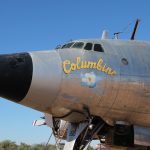The Palm Springs Air Museum in Palm Springs, California has just celebrated the return of their P-51D Mustang, 44-74908, following fourteen months of restoration work in Chino. The Mustang rolled off the production line on July 8th, 1945; too late to see combat in WWII. She became one of a hundred Mustangs to see service with the Royal Canadian Air Force in the post-war days before jets took her place. She joined 402 “City of Winnipeg” Squadron, one of the RCAF’s auxiliary units, serving until a forced landing in a farmer’s field put her “out to pasture” for the remainder of her Canadian service. It was probably that accident which saved her from the scrapper’s torch, as she went into storage, rather than being sold on to a South American air arm like a number of the other RCAF Mustangs. The fighter eventually passed through a number of civilian, US-based ownerships before Bob Pond acquired her in 1990 for his museum which is now known as the Palm Springs Air Museum. She flew until 2002, when the museum decided to ground her due to maintenance issues.
A few years ago, the museum decided to paint her to represent an example flown by Lieutenant Colonel Bob Friend, one of the famed Tuskegee Airmen. Lt.Col.Friend has become a great supporter of the museum over the years, so it was only natural that this Mustang become “his” Mustang. More recently, the museum decided they really wanted to get the P-51 flying again, so they contracted California Aerofab in Chino, California to go through the aircraft. The restoration saw the vintage fighter torn down to its smallest components before a total overhaul. She looks immaculate now, with a polished aluminum skin, and bearing the nose art for “Bunny”, Colonel Friend’s aircraft. She flew again for the first time in more than 12 years on February 9th, and after working off her hours, Matt Nightingdale, who played a large role in her restoration, flew the Mustang the short distance from Chino to Palm Springs on February 17th. The Palm Springs Air Museum will add a few bells and whistles to the aircraft over the next week or so before she is unveiled to the public on February, 27th. The Museum plans to hold her flying debut on February 28th. It should be quite a grand affair, with a couple of other Mustangs flying that day as well. Colonel Friend will be in attendance, along with a fellow Tuskegee airman, Rusty Burns.
The Mustang has been very expensive to return to flying condition, and the Palm Springs Air Museum could really use some extra donations to pay for what they’ve already accomplished. For those of you ready to help out, please do click HERE.
For a fascinating look at this Mustang’s restoration, please see the Facebook page HERE.





















